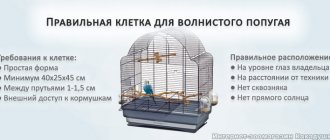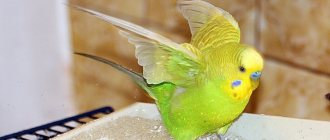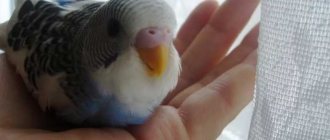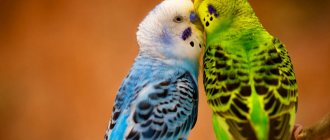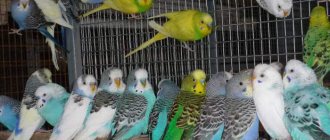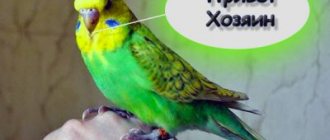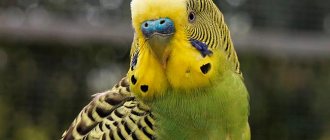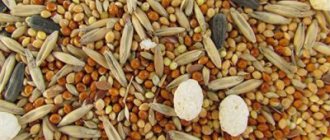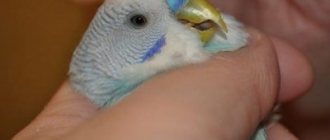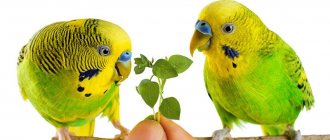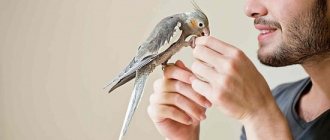Often, bird owners turn to the veterinarian with the question, why is my parrot’s beak peeling? Is this a disease? What caused the delamination? How to fix it? The answers to all questions are contained in our article.
Let's start with how the beak of a healthy parrot (budgerigar, lovebird, cockatiel) should look like. It should be shiny and smooth, evenly colored. If dullness, darkening, peeling, deformation, chips, cracks, or holes are present, this is a signal to take care of the bird’s well-being.
Healthy beak
Why does delamination occur?
When a pet gets sick, its beak becomes thin and fragile. Burrs are observed in some areas. The wax is covered with barely noticeable cracks and appears rough to the touch.
Beak separation can occur for a number of reasons:
- Lack of vitamins and minerals in the bird’s diet.
- Genetic predisposition.
- Bodily injury.
- Knemidocoptosis.
- Unfavorable indoor microclimate.
In some individuals, the beak grows too quickly, acquiring a hypertrophied shape. The bone tissue simply does not have time to form normally, so it begins to delaminate.
Injury
If a pet is injured, damaging its beak in some way, then during the regeneration process the surface is overgrown with a multi-layer protective film. In case of severe fractures, the outermost part dries out, and the remaining part also becomes covered with a white coating.
Knemidocoptosis
The disease gets its name from a type of tick. The activity of insects is manifested in the deformation of the beak, its peeling and delamination.
In addition to the unpleasant visual part, mites cause severe pain to the bird, which is why it constantly itches, sleeps anxiously and is in a state of stress.
If you carefully examine the bird, parasites can be seen at the base of the beak, as well as along the perimeter of the eye sockets. In the course of its activity, the pest creates a branched system of passages, which leads to the destruction of the bone structure, as well as to the appearance of delaminations.
Unbalanced diet
For the development of bones and beak in particular, the budgerigar's body requires a sufficient amount of calcium. If there is too little of it in food or for some reason the gastrointestinal tract does not absorb this element well, then hard tissues begin to peel off.
Lack of other vitamins and minerals can also cause beak splitting, but to a lesser extent. Therefore, nutrition must be balanced. Eating dry food alone is not enough: the diet must be diluted with fruits, vegetables and other products.
It is also useful to read: Fleas on a budgie
Control measures
If the owner notices that there is something wrong with the parrot’s beak, he will have to look for additional symptoms. If the paws are affected, then cnemidococcosis should be suspected and treatment should be started with aversectin ointment, which will destroy the parasite. At the same time, you should monitor your food intake. If the jaws are damaged, it is difficult for the perroque to eat; it may have to be force-fed with a semi-liquid mass from a syringe with the needle removed. If the prescribed measures do not produce results, they resort to the services of a veterinary ornithologist.
Force feeding
How to treat at home
As soon as your pet’s beak begins to peel and flake, urgent measures should be taken. First of all, it is necessary to adjust the bird’s diet. In addition to dry food, birds should be given sprouted grains, cottage cheese and boiled chicken eggs.
In pursuit of a balanced diet, it is important to ensure that the parrot does not overeat. Obesity in birds is very difficult and long to treat. Therefore, the daily norm must be strictly observed.
In order to cure a bird, veterinarians recommend mixing crushed chalk to the main food. If boiling eggs and feeding the bird cottage cheese is too troublesome, you can place a mineral stone or sepia in the cage. This will not only supplement the parrot’s diet with useful substances, but will also help him with grinding off the horny areas.
The microclimate in the room must correspond to the norm. Optimal conditions for budgies are +25⁰С with a humidity of 40-60%. Too high a room temperature and low humidity will cause the beak to split.
During the summer months, you can hang wet towels near the cage or use industrial humidifiers. In extreme heat, it doesn’t hurt to spray your pet with warm water from a spray bottle.
If peeling and tissue separation is caused by injury, then excess stratum corneum should be removed using a special tool. In this case, it is very important not to catch the blood vessels passing through the beak. Nail files cannot be used as a tool: the bird will experience severe discomfort.
Has your parrot been sick?
Not really
It is more advisable to shift any surgical intervention onto the shoulders of a specialist. The veterinarian has both the necessary tools and experience. You can remove only very small particles of the stratum corneum on your own.
If we are talking about the treatment of knemidocoptosis, then you should be patient. Getting rid of ticks is not so easy due to their tenacity and rapid reproduction. The first step is to isolate the sick bird from other pets.
Next, you need to carry out a complete disinfection of the cell. We remove all the accessories: drinking bowl, feeder, perches, bathing bowl, etc. For disinfection, it is better to use specialized industrial preparations. In the case of ticks, washing with soap alone cannot be done.
Many veterinarians prescribe Aversectin for knemidocoptosis. Depending on the level of infection, problem areas are treated with it every two or three days. Treatment is continued until the beak acquires a natural shine and familiar structure. When applying, it is very important to ensure that the medicine does not get on the animal’s mucous membrane, otherwise the pet will suffer from poisoning in addition to ticks.
Not all bird owners can make the correct diagnosis, so before using any medications you should consult a veterinarian.
Fractures and injuries
With severe bruises, cracks and chips appear on the horny tissue. The plates are split and the jaw bones are displaced. Where blood circulation is impaired, you can see that the beak has darkened. Less commonly, partial tearing of the organ occurs. Parrots, which contain several individuals in one cage, sometimes fight for territory. Violently attacking each other, the rivals inflict serious injuries and damage on each other. One of the most serious consequences of a fight is the tearing of the beak.
If the wound is relatively small, the veterinarian seals the crack with special glue and secures it with wire. Over time, a stratum corneum will grow in place of the broken part. But with a longitudinal fracture, a lot of effort is required to restore the functions of the beak and avoid tissue necrosis. It is difficult to leave a bird with such an injury, because you will have to feed it soft food for a very long time, while protecting it from unnecessary activity.
What to do for prevention
In order for the parrot to be healthy, including its beak, you need to take care of three things: nutrition, microclimate and cleanliness. The bird must receive all the vitamins and minerals necessary for its body, not be overheated or hypothermic, and also live in a clean cage.
Expert recommendations:
The cage should be kept away from heating devices. It is unacceptable for direct sunlight to fall on your pet.- In the winter months, if there is a lack of ultraviolet radiation, the room where the cage is located should be equipped with lamps. Your pet needs light at least 8 hours a day.
- The parrot must receive the elements necessary for bone growth. A mineral stone, sifted sand and/or sepia should be placed in the cage.
- All branches brought from the street must be doused with boiling water or disinfected with industrial means.
- Avoid low or high humidity. As soon as the level crosses the 80% mark, the doors to fungal infections will open.
- At least one perch should be irregularly shaped or made of an abrasive material to encourage the bird to groom its beak.
- Eliminate plastic from the cage (toys, crossbars, etc.), replacing it with natural materials or environmentally friendly synthetics.
- Give your pet fresh fruits and vegetables periodically. For chicks in the form of a paste, and for adults - in small pieces.
- Regularly inspect your bird for parasites.
Deformations
Although the beak is very hard and firmly attached, it can become deformed. There is a congenital malformation when a chick is born with an irregularly shaped horn. Most often, such birds do not survive because they do not adapt to grab food. The problem may go away over time if the top and bottom parts close together, otherwise the pet will need special care for the rest of its life.
If a parrot's beak becomes bent at an early age, when the keratoid membrane is pliable, things can still change. When the growth zone is affected, irreversible complications arise. With curved, intersecting halves, shape correction is possible. It is important to see the deformation in time and help the pet. Inexperienced owners do not immediately notice that the parrot’s beak has become crooked. The cause may be an adult bird colliding with an obstacle, for example, hitting glass.
Inflammation of the beak cavity
Inflammation of the mucous membrane of the beak cavity can be a consequence of mechanical damage from roughage, beak trauma, lack of vitamins, or burns. Visually, the disease is determined by the presence of a rough coating inside the beak, the inability of the bird to grab food, the beak is constantly in motion, as if something is bothering the bird. When the disease is advanced, the parrot does not eat, sits ruffled, quickly loses weight, and the beak does not close completely due to swelling. In the absence of timely treatment, the swelling reaches the nasopharynx and causes suffocation of the bird. Treatment consists of a balanced diet and a course of vitamin therapy. In advanced cases, a course of antibiotics is suggested.
Tags
The beak of unhappiness peels off. The beak of a healthy one flakes the beak flakes the beak flakes the beak the edge of the beak. Then the beak begins to flake the beak of the molting beak also. A healthy beak of a budgerigar flakes. a parrot flakes. a parrot flakes. a parrot flakes. I exfoliate the parrot exfoliates budgerigars often chewing by the parrot on hard budgerigars begins to eat solid food and solid feed.
diseases articles and body care commentary less content should cockatiel dogs ailment question such products on the back medications site medical tests clinic
Symptoms of felon
Symptoms of panaritium are distinguished depending on the form of the disease. However, in any form, a number of common symptoms are observed: in the initial stages of felon, there is redness, slight swelling and mild or moderate pain, possibly a burning sensation; then the swelling increases, the pain intensifies, becomes intense, bursting, tugging, depriving sleep.
A purulent focus forms in the area of inflammation, which is clearly visible in superficial forms of panaritium. The formation of an abscess may be accompanied by weakness, increased fatigue, headache and increased body temperature. Symptoms of intoxication are more pronounced in deep, severe forms of panaritium (bone, joint, tendon).
In addition, each form of panaritium has its own characteristic symptoms.
Cutaneous panaritium
